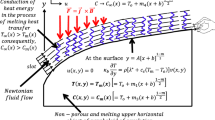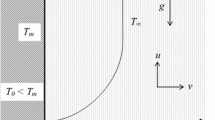Abstract
Three-dimensional melting of ice around a liquid-carrying tube placed in an adiabatic rectangular cavity is investigated mainly by means of a numerical analysis. Natural convection in the melt layer enhances melting by about 1.2 times compared with the approximate solution of a conduction mode derived from London and Seban and Hausen. The morphology of the melt layer changes in axial direction. Melting is not sensitive to the cavity height and the tube length, but is very responsive to the liquid inlet temperature.







Similar content being viewed by others
Abbreviations
- c :
-
Specific heat
- C:
-
Coefficient in flow resistance (=−10−6, Eq. 4)
- d i :
-
Inner diameter of the tube (=17.05 mm)
- d o :
-
Outer diameter of the tube (=19.05 mm)
- DTF :
-
Temperature range (0.2°C) in the mushy zone (0 ≤ f s ≤ 1)
- f :
-
Mass fraction
- F :
-
Flow resistance (Eq. 4)
- FS:
-
Solid mass fraction (=f s)
- h f :
-
Latent heat of melting
- H :
-
Height/width of the cavity
- k :
-
(effective) thermal conductivity
- log:
-
Logarithmic to natural base
- L :
-
Tube length
- Nud :
-
Nusselt number
- Pr:
-
Prandtl number
- r i :
-
Inner radius of the tube (=d i/2)
- r o :
-
Outer radius of the tube (=d o/2)
- Re:
-
Reynolds number
- t :
-
Time
- T :
-
Temperature
- T ph :
-
Melting temperature (0°C)
- T tube :
-
Fixed tube wall temperature in 2-D calculation
- T wℓ :
-
Temperature of working liquid in the tube
- u :
-
x-Component velocity
- v :
-
y-Component velocity
- V :
-
Velocity vector composed of u, v and w
- w :
-
z-Component velocity
- w m :
-
Mean velocity of the liquid flow in the tube
- x :
-
Horizontal coordinate
- y :
-
Vertical coordinate
- z:
-
Axial coordinate
- α m :
-
Mean heat transfer coefficient of the working liquid
- γ :
-
Volume fraction
- δ:
-
Melt layer thickness from the tube outer surface
- δ m :
-
Mean melt layer thickness on x–y plane
- δ mz :
-
Total mean melt layer thickness (= (δ m,z = 0 + δ m,z = 0.5L + δ m,z = L)/3, corresponding to the melt layer thickness calculated by the approximate solution)
- ρ :
-
Density
- Ini:
-
Initial
- Inlt:
-
Inlet
- ℓ:
-
Liquid (water)
- m:
-
Mean (averaged)
- s:
-
Solid (ice)
- wℓ:
-
Working liquid (flowing liquid in the tube)
- x :
-
x-direction
- y :
-
y-direction
- z :
-
z-direction
References
Sparrow EM, Hsu CF (1981) Analysis of two-dimensional freezing on the outside of a coolant-carrying tube. Int J Heat Mass Transf 24–8:1345–1357
Shamsundar N (1982) Formulae for freezing outside a circular tube with axial variation of coolant temperature. Int J Heat Mass Transf 25–10:1614–1616
Shamsundar N, Srinivasan R (1980) Effectiveness-NTU charts for heat recovery from latent heat storage units. ASME J Heat Transf 102:263–271
Sasaguchi K, Imura H, Furusho H (1986) Heat transfer characteristics for latent heat storage system with finned tube (1st Report: experimental study for solidification and melting processes) (in Japanese). Trans Jpn Soc Mech Eng (Ser B) 52–473:159–166
Sasaguchi K, Imura H, Furusho H (1986) Heat transfer characteristics for latent heat storage system with finned tube (2nd Report:comparison of numerical and experiment for solidification processes) (in Japanese). Trans Jpn Soc Mech Eng (Ser B) 52–473:167–173
Sugawara M, Komatsu Y, Makabe T, Beer H (2009) Three dimensional freezing around a coolant-carrying tube. Heat Mass Transf. doi:10.1007/s00231-010-0651-1
Sugawara M, Beer H (2009) Numerical analysis for freezing/melting around vertically arranged four cylinders. Heat Mass Transf 45:1223–1231
Sasaguti K, Takeo H (1994) Effect of the orientation of a finned surface on the melting of frozen porous media. Int J Heat Mass Transf 37–1:13–26
London AL, Seban RA (1943) Rate of ice formation, transactions of the ASME, October, pp 771–778
Hausen H (1943) Darstellung des Warmeuberganges in Rohren durch verallgemeinerte Potenzbeziehungen. Z VDI Beih Verfahrenstech 4:91–98
Katto Y (1974) Introduction to heat transfer (Dennetsu Gairon in Japanese), Yokendo Press, Tokyo, pp 55–57
Acknowledgments
The authors wish to acknowledge support for this study by the technical official T. Fujita.
Author information
Authors and Affiliations
Corresponding author
Rights and permissions
About this article
Cite this article
Sugawara, M., Komatsu, Y. & Beer, H. Three-dimensional melting of ice around a liquid-carrying tube. Heat Mass Transfer 47, 139–145 (2011). https://doi.org/10.1007/s00231-010-0676-5
Received:
Accepted:
Published:
Issue Date:
DOI: https://doi.org/10.1007/s00231-010-0676-5




